At Aquariadise, we’ve written dozens of guides to the best algae eaters for freshwater aquariums. Dwarf shrimp are some of the best algae eaters you can hope to find, and none do a better job than the amazing Amano shrimp!
Here we’ll take you through everything you need to know about these helpful crustaceans which make an excellent addition to community tanks with algae issues.
Key Takeaways:
- Amano shrimp are easy-to-keep invertebrates that are probably the best algae eaters of all dwarf shrimp species.
- Because they can’t reproduce in freshwater, Amano shrimp will never overpopulate your aquarium like many other species of dwarf shrimp and snails do.
- As peaceful crustaceans, Amano shrimp do well in community tanks with small, peaceful fish and other docile invertebrates.
Amano Shrimp Care at a Glance
| Amano Shrimp Info | |
|---|---|
| Scientific names | Caridina multidentata, Caridina japonica |
| Minimum tank size | 10 gal (38 L) |
| Temperament | Peaceful |
| Diet | Omnivore |
| Temperature | 65-81 °F |
| pH | 6-7.6 |
| Max. length | 2” |
| Lifespan | 3-5 Years+ |
| Care level | Easy |
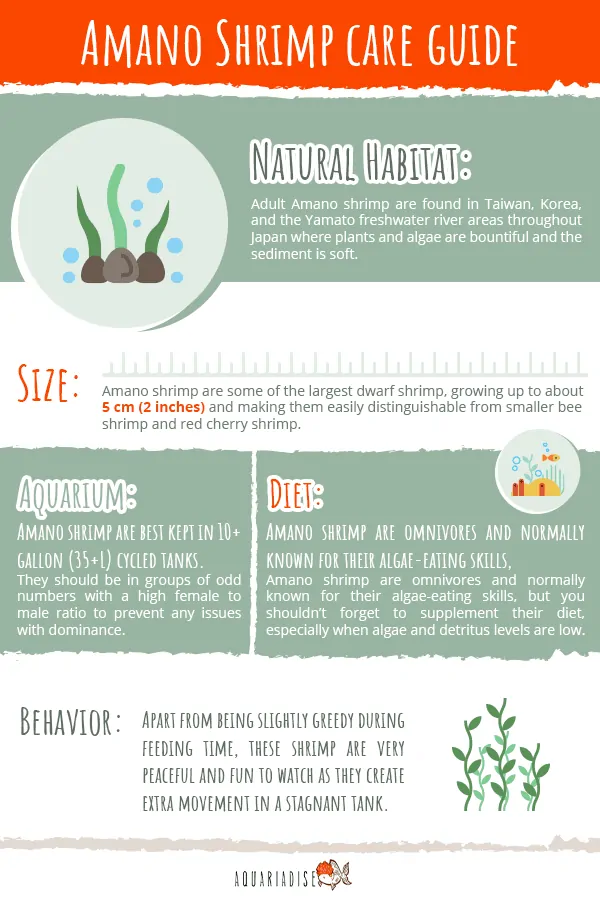
Origin and Background
Caridina multidentata (formerly known as Caridina japonica) is commonly called Amano shrimp, Japonica shrimp, or Yamato shrimp. They are categorized as freshwater algae-eating dwarf shrimp.
Natural Habitat
Adult Amano shrimp are found in Taiwan, Korea, and the Yamato freshwater river areas throughout Japan where plants and algae are bountiful and the sediment is soft. They move to brackish water or saltwater areas during breeding periods.
Because the larvae need this saltier water to survive the first few stages of life, the majority of Amano shrimp present in hobby aquariums are wild-caught.
Identification
Amano shrimp are some of the largest dwarf shrimp, growing up to about 5 cm (2 inches) and making them easily distinguishable from smaller bee shrimp and red cherry shrimp. They can easily be recognized by their grayish transparent bodies with rows of dots on each side.
The coloring and size of these dots can vary with diet, ranging from reds and browns to blues and grays. Sometimes, these algae-eating shrimp will also have hints of green that help them blend into their environment.
These dots are also used to help identify the males from the females. Female Amano shrimp are typically larger and have a bottom row of longer dashes instead of short dots. Females also carry small eggs in the saddle section of their abdomens and can be seen waving water over the nest to supply oxygen.
We will further discuss breeding and mating behaviors later in the article, as well as the difficulties of raising Amano fry in an aquarium setting.
Amano Shrimp Tank Setup
Part of what makes Amano shrimp such a great addition to aquariums is that they don’t demand very specific water parameters or temperatures. As hardy shrimp, they will thrive in any freshwater tank that is well-established with plants and algae.
Tank Size
Amano shrimp are best kept in 10+ gallon (35+L) cycled tanks. They should be in groups of odd numbers with a high female-to-male ratio to prevent any issues with dominance.
As a general rule, it’s better not to stock more than one Amano shrimp for every two gallons of water, and increased bioload should always be considered per system.
Tank Environment
Amano shrimp are plant-dwelling crustaceans that love to hide among dense plant foliage. By adding live plants to the tank, you’ll be helping to recreate the Amano’s natural habitat in your aquarium, and they’ll return the favor by cleaning algae and biofilm from the plant leaves!
Plants like Java moss, Java fern, and Amazon sword are easy to grow, provide excellent coverage, and make for a natural-looking aquarium.
Some rocky caves and pieces of driftwood can also enhance your shrimp tank aquascape and offer additional places for your shrimp to hide and feed from.
Strange but true: The more hiding places you provide, the more you’ll see your Amano shrimp. They’ll feel safer and more confident venturing into open spaces if they know they can retreat to a hide quickly.
Do Amano Shrimp Eat Live Plants?
Another asset of keeping Amano shrimp is that they very rarely feed on live plants. While they’ll sometimes pick off dead or decaying plant leaves to tidy up your tank, they’ll only ever eat live plant leaves if they’re incredibly hungry and simply need feeding more often!
Tank Mates
Amanos may be kept with other small, peaceful, community fish and invertebrate species, or in a single-species aquarium.
Small fish such as neon tetra, guppies, platies, danios, corydoras catfish, and rasboras all make great tank mates for fully-grown Amanos. But since larger fish such as cichlids, gouramis, and loaches could pose a threat to your Amano shrimp, it’s better not to keep them in the same tank.
Because Amanos are one of the largest species of popular freshwater shrimp, they’re also one of the more robust candidates to be kept alongside the ever-popular, but often aggressive betta fish.
If you do decide to keep Amano shrimp alongside aggressive fish, be sure to add live plants and shrimp tubes to give them the best chance of escaping from danger.
Amano shrimp (Caridina multidentata) may also be housed with other algae-eating shrimp, such as ghost shrimp (Palaemonetes paludosus), red cherry shrimp (Neocaridina davidi), or bee shrimp (Caridina cantonensis), as long as an ample food supply is provided.
Diet and Nutrition
Although Amano shrimp are often admired for their algae-eating antics, you shouldn’t forget to supplement their diet, especially when algae and detritus levels are low. Our aquariums often don’t produce enough algae to sustain a group of shrimp, which can leave them hungry.
Insufficient feeding can cause fatalities when it’s time for the shrimp to molt because a new exoskeleton requires a lot of calcium and other nutrients to develop successfully.
Feeding
Amano shrimp are omnivores, so they’ll accept most kinds of food. They do best when fed on a mixed diet:
- Specialized shrimp foods such as shrimp pellets are preferred.
- I tested the GlasGarten brand shrimp food with my Amano shrimp and they seemed to love it, so if you’re looking for a staple food it might be a good option. You can find my review here.
- Algae wafers and Spirulina wafers are excellent supplements for shrimp that lack enough algae in the tank to keep them nourished.
- For some great extra variety in their diet, you can feed your Amanos blanched vegetables like cucumber, zucchini, lettuce, and spinach.
- Some shrimp enthusiasts prefer to feed their Amanos the richly nutritious leaves of edible wild plants like blanched dandelions and nettles!
- Frozen foods, such as mosquito larvae, blood worms, and brine shrimp, shouldn’t make up the bulk of the shrimps’ diet but can be fed occasionally to provide extra nutrients.
- Regular tropical fish food in the form of fish flake food or fish pellets will happily be eaten as well.
Avoiding Overfeeding
Remember that rotting fish foods can cause serious water quality issues. Even if you’re relying on your Amano shrimp to clean up after their tank mates, don’t forget to manually remove most types of fish food within 20 minutes to keep the water clean.
In contrast, blanched leaves such as nettles and spinach can be left in the tank for up to 12 hours without causing problems.
Algae Eating and Tank Cleaning
Amanos first came to fame in the 1980s after Takashi Amano, a renowned Japanese aquarist, discovered how effective they are at cleaning algae. They have since become a staple clean-up crew member in the freshwater aquarium hobby.
As scavengers, Amanos will typically eat anything that is put in front of them. Because they are larger than most other shrimp, they will be the first to grab any flakes or sinking pellets. It is important to remember that all other shrimps and smaller invertebrates will likely end up with what your Amanos haven’t finished.
Despite their voracious appetites, Amano shrimp are known to be picky; they will likely eat anything and everything else before resorting to nuisance algae. To pique your shrimp’s interest in the detritus in your tank, you may have to temporarily withhold additional food items!
Amano shrimp have a special status among cleaner shrimp because they’re one of the few species that will eat black beard algae and green hair algae, placing them on the best aquarium algae eaters list.
Behavior
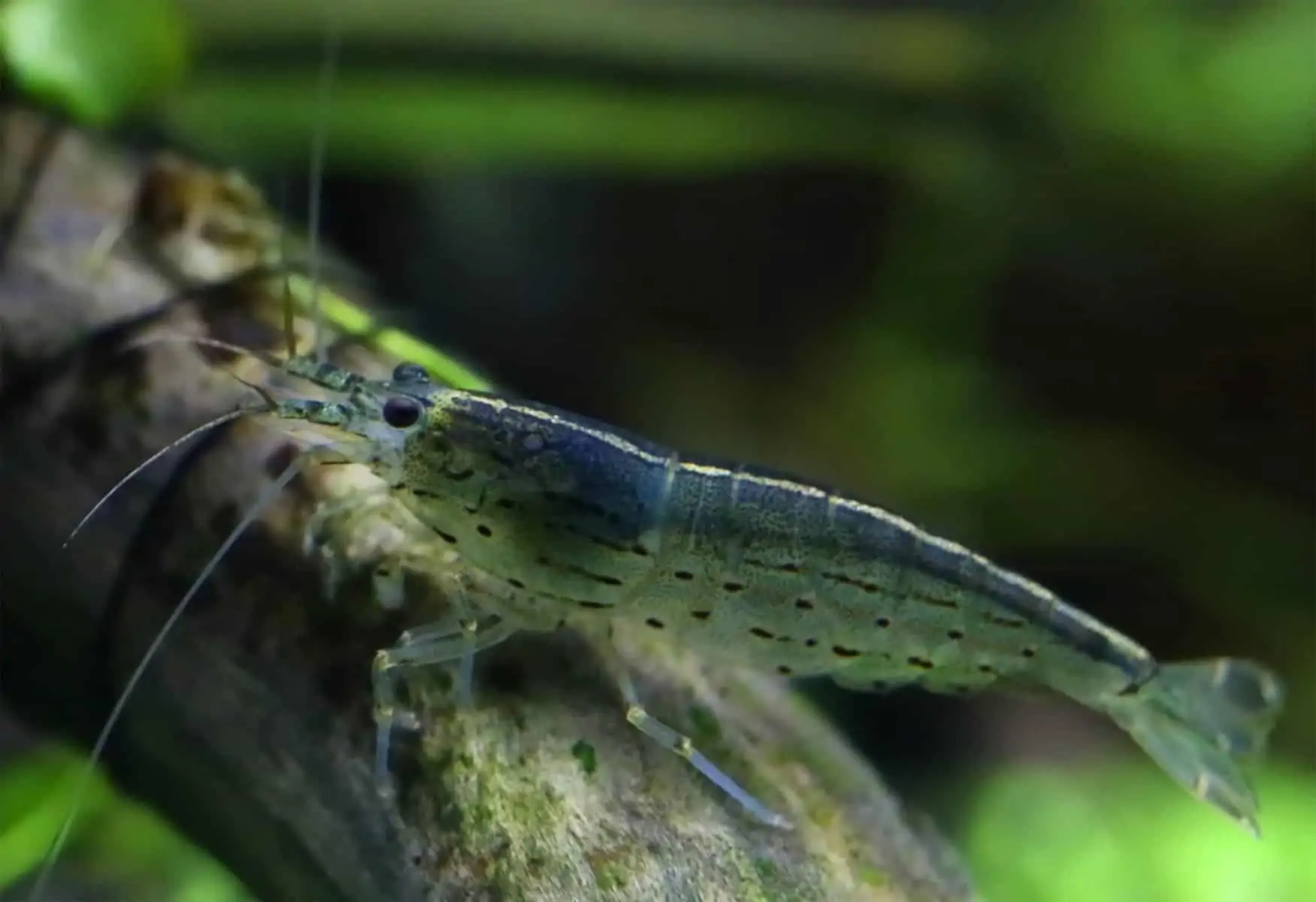
Apart from being slightly greedy during feeding time, these larger freshwater shrimp are very peaceful and fun to watch as they create extra movement in a stagnant tank.
They spend most of their time foraging for leftover bits of food in a group but also swim around occasionally, especially after water changes and during mating periods.
During mating periods, which usually occur after a female’s molt, Amano shrimp will exhibit a sort of ‘dance.’ At this time, females may be chased around the tank in efforts made by the male to mate.
Hover over the image to pin it to Pinterest!
Temperament – Do Amano Shrimp Eat Fish?
Amano shrimp are renowned for being very peaceful shrimp. While some people have had trouble with Whisker Shrimp (often confused with Ghost Shrimp) attacking and eating small fish, Amanos are a benign species, more interested in eating algae and dead plants.
While there are stories of groups of Amano shrimp ganging up and eating small fish on fish-keeping forums, these were likely mislabeled Whisker Shrimp or other Macrobrachium species that do prey on healthy fish.
On the occasions where true Amanos have been seen eating fish, it’s most likely that the fish was dead or close to dying already.
Molting
About every month and a half, freshwater shrimp go through a molting process as they grow. Don’t be alarmed! It is very easy to mistake an empty shell for a dead shrimp when first looking into your tank.
If you can’t tell if your shrimp has molted, allow a few hours to go by. Amano shrimps will hide after molts as this is when they are most vulnerable, so keep your eye out for if yours reappears during this time.
If there are no signs at all of your shrimp after a few hours, try retrieving the object from the tank to make sure it is a shell rather than a dead shrimp. If it wasn’t a molt, you should test your water parameters to make sure that the tank is still stable.
Health and Diseases
Amanos are a typically robust species that rarely suffer significant health problems or ailments in aquariums.
One way that some aquarists accidentally kill their shrimp, however, is with copper-based medications. While copper compounds can be an effective remedy against various fish diseases, the element is highly toxic to invertebrates like shrimp, snails, crayfish, and crabs – even in small doses.
If you have accidentally treated your aquarium with a copper-based medicine, you either need to transfer your shrimp to another tank as soon as possible to save their lives, or otherwise make thorough water changes to remove most of the copper from the water.
Lifespan
Amano shrimp often only live for 2-3 years in home aquariums, but this is by no means their maximum lifespan!
When well-cared for, these excellent algae eaters can exceed 5 years, and some reports on the internet even suggest that they can occasionally reach 10 years old!
This is a long time for a dwarf shrimp. Other popular dwarf shrimp such as cherry shrimp often only live for 1-2 years.
Breeding Amano Shrimp
In the aquarium trade, Amano shrimp are often wild-caught because they’re notoriously difficult to breed. More specifically, the problem is not so much that they’re hard to breed, but rather, keeping the fry alive. You’ll often see females carrying eggs, but hatching and raising the young is the hard part.
Unlike most dwarf shrimp species, which hatch as tiny copies of their parents, Amano shrimp start their lives as larvae that require brackish or saltwater. After their larval stage, they need to be transferred back to freshwater. In a normal freshwater aquarium the larvae often simply end up as food for the other fish or die shortly after hatching.
This means you’ll often see your female Amanos carrying eggs between their swimmerets (back legs) and being chased by the males, but never any fry. It’s pretty difficult to breed Amano shrimp, but a few experienced aquarists have reported success.
If you’d like to try your hand at breeding Amano shrimp, consider checking out the article on Amanos that I wrote for Aquarium Hobbyist Magazine a while back. It contains more info about the process of rearing the fry. Challenging, but not impossible – it has been done! You can find the article here (Q1 2018, p. 10-12).
Amano Shrimp vs Cherry Shrimp
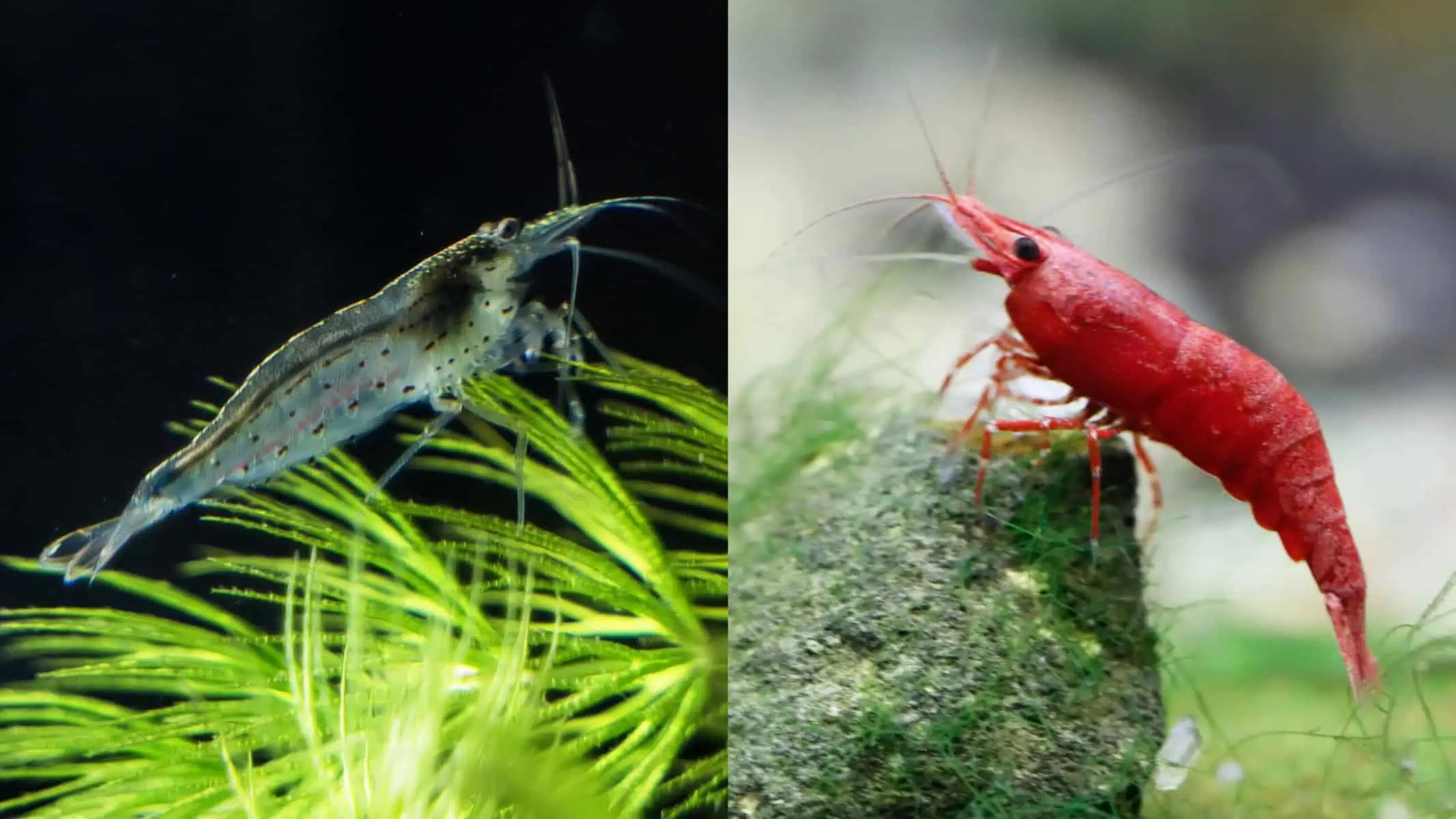
It’s worth comparing Amano shrimp to another extremely popular freshwater shrimp – the cherry shrimp.
One of the first differences you’ll notice is that cherry shrimp are significantly smaller. While female Amano shrimp can often exceed 2 inches in length, cherry shrimp usually reach a maximum of 1-1.5 inches long.
Equally glaring is the color difference. Whereas Cherry shrimp come in a variety of reddish colors, the modest Amano is largely translucent.
In regards to breeding, cherry shrimp can breed rampantly in freshwater and easily overpopulate a small aquarium, whereas Amanos are unable to reproduce in freshwater so are easier to manage in this way.
But which shrimp is the best algae eater? The consensus among most shrimp specialists is that Amanos are the kings of the algae-eating dwarf shrimp. They outcompete cherry shrimp and ghost shrimp in the quantity and variety of algae that they eat.
Buying Guide
Because most Amano shrimp are wild-caught, they tend to be more expensive than other similar shrimp. If you’re looking to buy Amano shrimp be sure to look for ones that appear healthy and are actively foraging and moving around.
The size of each shrimp should be considered given the fish and other invertebrates already in your tank. Amanos with a milky-colored body and shrimp that sit motionlessly might not make it, so you’re best off avoiding those.
You can buy Amano shrimp online here:
- Live Arrival Guarantee.
- Size:Juvenile Shrimps 1/4"-1/2" or longer
Conclusion
Amano shrimp are one of the most popular freshwater shrimp for good reason. They’re very likely the best algae eater of all shrimp, and since they can’t breed in freshwater, they’ll also never overpopulate your aquarium!
Because Amanos are slightly larger and more robust than cherry or ghost shrimp, they’re also less likely to get harmed or eaten by your fish. Not bad for a low-maintenance critter that’s easy to keep!

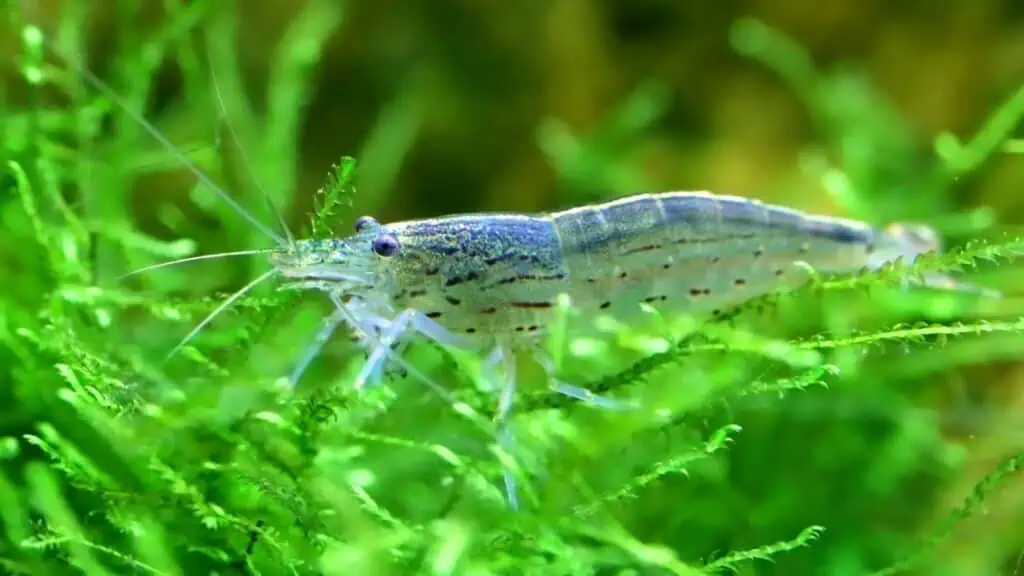
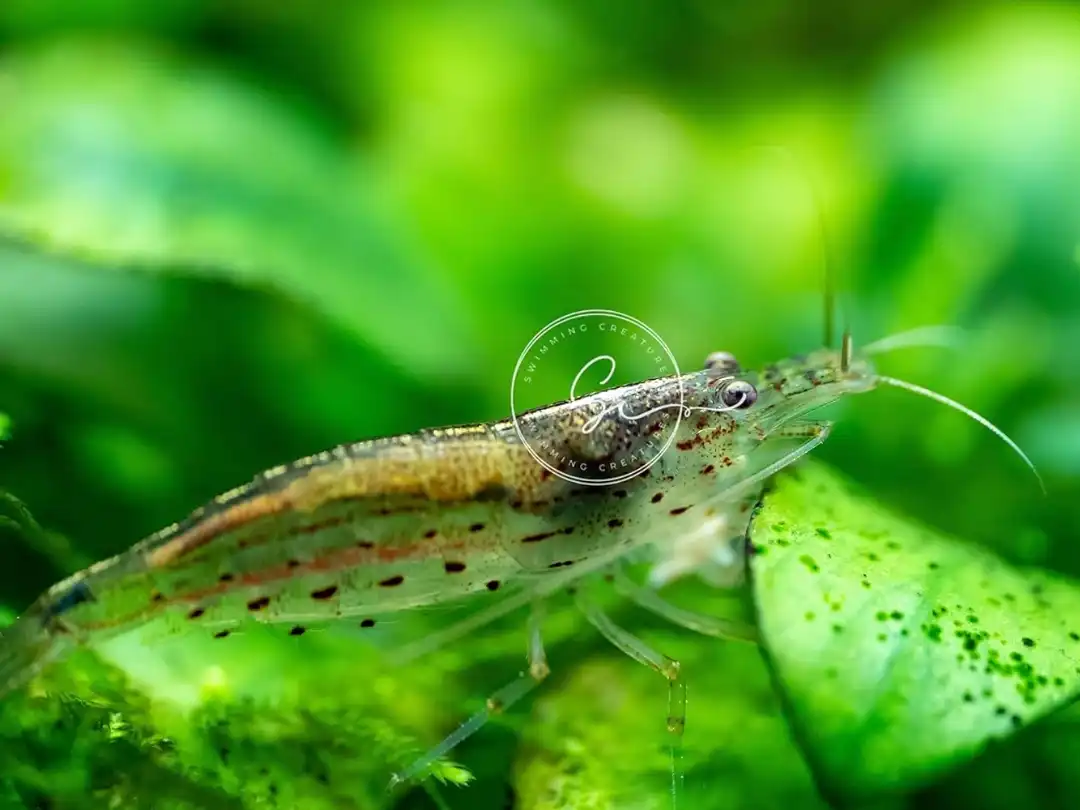

Thanks for the great articles! We have 3 big amanos in densely planted 60 liters together with tetras, coridoras and a pair of ram cichlids. We enjoy them a lot! They love to steal food from anyone and it’s very funny! Ramirezi tried to bite them a couple of times, but amanos scared them, tickling with antennas 😀 Initially they were very shy and were hidding behind the filter for a two months, getting out only at night. But now they are big and bold and clean plants for a whole day.
Thanks for sharing, I’m glad you’re enjoying your Amanos! 🙂
Are they as easy to breed as Cherry Shrimp?
As mentioned in the article, Amano shrimp are almost impossible to breed in the home aquarium because they go through a larval stage where they require brackish water. To answer your other question, Amanos and Cherry shrimp can definitely be kept together! Ghost shrimp are a little more aggressive, but it should still work as well. 🙂
Can they be kept with Ghost Shrimp and Cherry Shrimp? Will that cause them to cross breed with each other?
Hey Mari! Glad to hear you’ve had good experiences with Amanos. I want to get one for my community and was wondering more about your community. What size is it? What fish are in there? Just trying to research as much as I can before I buy!
We kept them in a 20gal for a very long time and just recently moved them to a 30gal when the old tank broke. We keep cardinal tetras in there, as well as one Chinese algae eater we bought when we didn’t know better and a whole load of cherry shrimp.
If you do get Amanos, I’d recommend getting more than one, it’s fun to see them foraging together!
I had some Amano shrimp but they climbed out of the tank. I have a 29 gallon planted tank. Why do they do this?
Hi Colleen!
Most aquarium fish and invertebrates are escape artists. I’ve had fish get out of a fully covered tank before. I really have no idea how they did it.
While this could have been because they got scared or tried to eat something off the surface of the water, it could also be that your water parameters are unideal. Test your water. If your parameters are good, then your shrimp most likely just got scared.
If you have other shrimp or even snails in the tank, try to get an aquarium hood/cover as soon as you can.